
Humboldt County is a county located in the U.S. state of California. As of the 2020 census, the population was 136,463. The county seat is Eureka.

Arcata is a city adjacent to the Arcata Bay (northern) portion of Humboldt Bay in Humboldt County, California, United States. At the 2020 census, Arcata's population was 18,857. Arcata was first colonized in 1850 as Union, was officially established in 1858, and was renamed Arcata in 1860. It is located 280 miles (450 km) north of San Francisco, and is home to California State Polytechnic University, Humboldt. Arcata is also the location of the Arcata Field Office of the Federal Bureau of Land Management, which is responsible for the administration of natural resources, lands and mineral programs, including the Headwaters Forest, on approximately 200,000 acres (810 km2) of public land in Northwestern California.
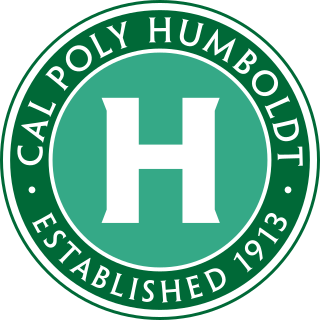
California State Polytechnic University, Humboldt is a public university in Arcata, California. It is one of three polytechnic universities in the California State University (CSU) system and the northernmost campus in the system. The main campus, situated hillside at the edge of a coast redwood forest, has commanding views overlooking Arcata, much of Humboldt Bay, and the Pacific Ocean. The college town setting on the California North Coast, 8 miles (13 km) north of Eureka, 279 miles (449 km) north of San Francisco, and 654 miles (1052.51 km) north of Los Angeles is notable for its natural beauty. It is the most westerly four-year university in the contiguous United States. Humboldt is an Hispanic-serving institution (HSI).

The Detroit Opera House is an ornate opera house located at 1526 Broadway Street in Downtown Detroit, Michigan, within the Grand Circus Park Historic District. The 2,700-seat venue is the home of productions of the Detroit Opera and a variety of other events. The theatre was originally designed by C. Howard Crane, who created other prominent theatres in Detroit including The Fillmore Detroit, the Fox Theater and the Detroit Symphony's Orchestra Hall. It opened on January 22, 1922.

The Chicago Theatre, originally known as the Balaban and Katz Chicago Theatre, is a landmark theater located on North State Street in the Loop area of Chicago, Illinois. Built in 1921, the Chicago Theatre was the flagship for the Balaban and Katz (B&K) group of theaters run by A. J. Balaban, his brother Barney Balaban and partner Sam Katz. Along with the other B&K theaters, from 1925 to 1945 the Chicago Theatre was a dominant movie theater enterprise. Currently, Madison Square Garden, Inc. owns and operates the Chicago Theatre as a performing arts venue for stage plays, magic shows, comedy, speeches, sporting events and popular music concerts.

Bayside is an unincorporated community 2.25 miles (3.6 km) south-southeast of Arcata, at an elevation of 33 feet in Humboldt County, California. The ZIP Code is 95524, the area code is 707. The relatively large area was originally covered by large, ancient Coast Redwood trees down to what was the edge of a significantly larger Humboldt Bay at high tide. Later, the mammoth redwoods made it the natural placement of some of the area's earliest redwood lumber operations. A rock quarry was located in the area's hills, which form the beginning of the Coast Ranges, the source of water for an early public water system for the City of Arcata. Today, Bayside provides Arcata a buffer from Eureka's northward expansion along US Route 101 and the area, with the exception of some business and public buildings, is largely rural, with homes and small ranches dotting the landscape. Second growth forests exist mostly apart from cleared lands, which show some evidence of the extensive redwood forest that once existed in the form of large stumps. Some of the area's older Victorian era houses, are still present on the Old Arcata Road, the original main road connecting Arcata to Eureka. Jacoby Creek runs alongside a road of the same name from the hills in the direction of the Bay.

Arcata Wastewater Treatment Plant and Wildlife Sanctuary is an innovative sewer management system employed by the city of Arcata, California.

The Arcata Community Forest is part of the parks and recreation system of the City of Arcata, California, United States. It was originally created in 1955 from six forest tracts: Gannon Tract, Burns Tract, Preston Tract I, Preston Tract II, Reclamation Water Co. Tract, and Brizard Tract. The main forest area covers 793 acres (3.21 km2). The park was the culmination of efforts to combine tracts of forest land located east of the city together in one continuous section of city-owned second-growth coast redwood forest. Over a 50-year period, 622 acres (2.52 km2) were obtained in several purchases. In November 2006, the 171-acre (0.69 km2) Sunny Brae Forest was added to the Community Forest. The city also owns and manages the 1,200-acre (4.9 km2) Jacoby Creek Forest. The City owns a total of 2,134 acres (8.64 km2) of forest."

The Arcata Theatre Lounge is a historic structure located in the city of Arcata in Humboldt County, California.
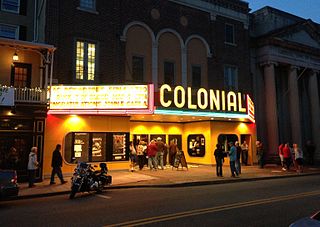
The Colonial Theatre is located in Phoenixville, Pennsylvania, at 227 Bridge Street. Built in 1903, the "Colonial Opera House" became a preeminent venue for movies, traveling shows and live entertainment throughout the 20th century. The three-screen venue consists of the original 658-seat ‘vaudeville house’ and two newer additional theatres in the adjacent National Bank of Phoenixville building (c.1925).
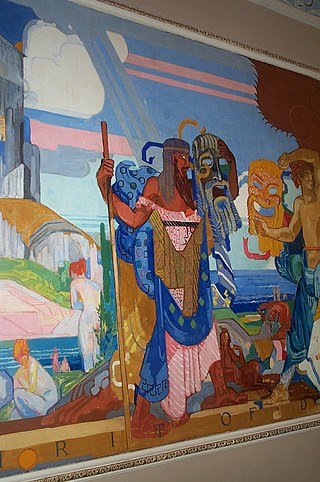
The KeyBank State Theatre is a theater located at 1519 Euclid Avenue in downtown Cleveland, Ohio. It is one of the theaters that make up Playhouse Square. It was designed by the noted theater architect Thomas W. Lamb and was built in 1921 by Marcus Loew to be the flagship of the Ohio branch of the Loew's Theatres company.
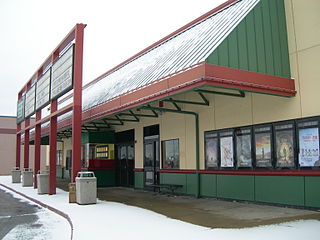
Lakehurst Cinemas was a multiplex movie theatre located in Waukegan, Illinois, United States, that operated from 1974 until 2007.
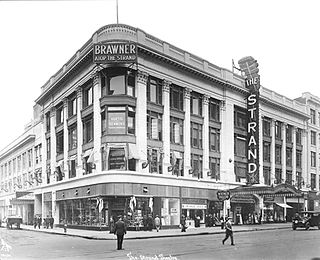
The Strand Theatre was an early movie palace located at 1579 Broadway, at the northwest corner of 47th Street and Broadway in Times Square, New York City. Opened in 1914, the theater was later known as the Mark Strand Theatre, the Warner Theatre, and the Cinerama Theatre. It closed as the RKO Warner Twin Theatre, and was demolished in 1987.
The Big Lagoon Rancheria is a federally recognized tribe of Yurok and Tolowa Indians. They are located in Humboldt County, California, and their tribal headquarters is in Arcata, California.

The Broadway Theater District in the Historic Core of Downtown Los Angeles is the first and largest historic theater district listed on the National Register of Historic Places (NRHP). With twelve movie palaces located along a six-block stretch of Broadway, it is the only large concentration of movie palaces left in the United States. The same six-block stretch of Broadway, and an adjacent section of Seventh Street, was also the city's retail hub for the first half of the twentieth century, lined with large and small department stores and specialty stores.

The Capitol Theatre was a movie palace located at 1645 Broadway, just north of Times Square in New York City, across from the Winter Garden Theatre. Designed by theater architect Thomas W. Lamb, the Capitol originally had a seating capacity of 5,230 and opened October 24, 1919. After 1924 the flagship theatre of the Loews Theatres chain, the Capitol was known as the premiere site of many Metro-Goldwyn-Mayer (MGM) films. The Capitol was also noted for presenting live musical revues and many jazz and swing bands on its stage.
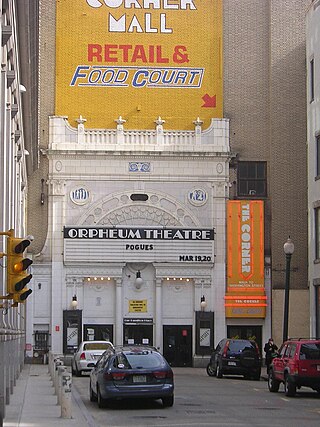
The Orpheum Theatre is a music venue located at 1 Hamilton Place in Boston, Massachusetts. One of the oldest theaters in the United States, it was built in 1852 and was originally known as the Boston Music Hall, the original home of the Boston Symphony Orchestra. The concert hall was converted for use as a vaudeville theater in 1900. It was renamed the Orpheum Theatre in 1906. In 1915, the Orpheum was acquired by Loew's Theatres and substantially rebuilt. It operates as a mixed-use hall, primarily for live music concerts.
Korbel is an unincorporated community in Humboldt County, California. It is located 1.5 miles (2.4 km) east-southeast of Blue Lake, at an elevation of 154 feet. The ZIP Code is 95550.
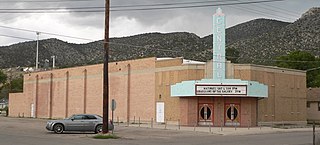
The Central Theater was built in Ely, Nevada from 1939 to 1941. The Art Deco style cinema was built by Percy and Warren Hull after they were denied permission to expand Ely's Capital Theater, which opened in 1916. Originally it was built as a 725-seat theater. The Central is unusual in a town where most of the structures were built in the boom times of the early 20th century. The one story building features a vertical CENTRAL neon sign over the marquee. The interior features curved surfaces and is in a good state of preservation.

The Joy Theater, named after owner Joy Houck, is a theater and historic landmark built in 1947 on Canal Street in downtown New Orleans, Louisiana. Renovations in 2011 transformed the former movie palace into a multi-purpose theater for live music, stand-up comedy, private functions, and corporate events. The theater's iconic marquee sign was restored, as was the building's original art deco architecture.



















